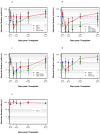Double umbilical cord blood transplantation with reduced intensity conditioning and sirolimus-based GVHD prophylaxis
- PMID: 20697368
- PMCID: PMC3012740
- DOI: 10.1038/bmt.2010.192
Double umbilical cord blood transplantation with reduced intensity conditioning and sirolimus-based GVHD prophylaxis
Abstract
The main limitations to umbilical cord blood (UCB) transplantation (UCBT) in adults are delayed engraftment, poor immunological reconstitution and high rates of non-relapse mortality (NRM). Double UCBT (DUCBT) has been used to circumvent the issue of low cell dose, but acute GVHD remains a significant problem. We describe our experience in 32 subjects, who underwent DUCBT after reduced-intensity conditioning with fludarabine/melphalan/antithymocyte globulin and who received sirolimus and tacrolimus to prevent acute GVHD. Engraftment of neutrophils occurred in all patients at a median of 21 days, and platelet engraftment occurred at a median of 42 days. Three subjects had grade II-IV acute GVHD (9.4%) and chronic GVHD occurred in four subjects (cumulative incidence 12.5%). No deaths were caused by GVHD and NRM at 100 days was 12.5%. At 2 years, NRM, PFS and OS were 34.4, 31.2 and 53.1%, respectively. As expected, immunologic reconstitution was slow, but PFS and OS were associated with reconstitution of CD4(+) and CD8(+) lymphocyte subsets, suggesting that recovery of adaptive immunity is required for the prevention of infection and relapse after transplantation. In summary, sirolimus and tacrolimus provide excellent GVHD prophylaxis in DUCBT, and this regimen is associated with low NRM after DUCBT.
Figures




References
-
- Laughlin MJ, Eapen M, Rubinstein P, et al. Outcomes after Transplantation of Cord Blood or Bone Marrow from Unrelated Donors in Adults with Leukemia. N Engl J Med. 2004;351:2265–2275. - PubMed
-
- Rocha V, Labopin M, Sanz G, et al. Transplants of Umbilical-Cord Blood or Bone Marrow from Unrelated Donors in Adults with Acute Leukemia. N Engl J Med. 2004;351:2276–2285. - PubMed
Publication types
MeSH terms
Substances
Grants and funding
LinkOut - more resources
Full Text Sources
Research Materials

